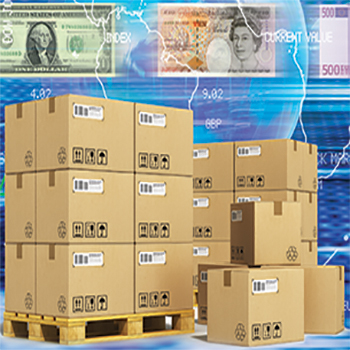Freight Payment Enters a New Dynamic Analytical Global Era

Using analytics and Big Data, the next generation of freight bill payment and auditing companies comb all aspects of freight transportation operations to highlight supply chain efficiency improvement opportunities.
One thing is for sure: These are not your grandfather’s freight payment companies.
The freight bill payment industry has evolved from the manual, “green eye shade” era of correcting regulated trucking rates to a high-tech, globalized industry that attempts to make the most of Big Data to analyze freight shipping trends and help streamline overall supply chain operations.
Although post-payment auditing is still part of a freight payment company’s repertoire, analysts and senior officials within these organizations say increasingly that their most important value to clients is in pre-payment auditing, planning, benchmarking, and analytics.
While shippers can still do some of this data analysis in-house, experts say that the information systems required to stay on top of these analytics are expensive and constantly changing.
And shipments are now going around the globe, not just around the corner, making data collection and analysis even more complex for do-it-yourselfers.
“Our view is that you don’t need to audit every invoice - you need to verify one every so often,” says Satish Jindel, president of ShipMatrix, a company that performs rate invoice verification, mostly for parcel and less-than-truckload (LTL) clients.
The company has several hundred customers who spend in excess of $3 billion on transportation, he says. “They need help in finding efficiencies, not merely auditing freight bills,” he adds.
Today, freight payment is merely a fraction of what most of these companies do. Instead, computer-driven technology has taken the lead, trying to maximize efficiencies not merely through audits, but rather by close examination of a shipper’s freight trends and tendencies.
However, the introduction of computerization into the freight payment world is just one of the changes affecting the market. The other is merely the scope of the industries that today’s freight payment companies are tracking.
“The biggest change in the freight audit payment space is that now we encompass the entire globe,” says Allan Miner, president of CT Logistics, a freight payment company founded in 1923 that has grown to 1,000 clients with operations around the world. “Our ability and need to be able to audit in different currencies and different languages, and put that into one common corporate data base for corporate intelligence, is very important.”
Mike Regan, president of TranzAct, an operation that began in 1984, says that the marketplace for freight payment services companies has changed in three ways. First, he says, the nature of the competition is different. “Previously, competition came in the form of mom-and-pop operators,” he says. “Today we’re competing against Oracle, SAP, as well as C.H. Robinson.”
Second, Regan says that what customers are expecting and what they’re willing to pay for has changed. “They’re looking for better data quality, better reporting, better services at a lower price. You can have price, speed, or service, but not all three.”
The third change, according to Regan, comes along with the data information revolution. When TranzAct was formed, it concentrated on processing and payment of freight bills exclusively.
Now, he says, it uses transportation management systems (TMS) to provide automated load tendering and tracking, a company-developed system called ShipperShield to look at carriers’ Compliance, Safety, Accountability (CSA) scores, and a technology group that rates carriers’ risk and performance metrics against the freight rates they are offering.
“Shippers are looking for a lot of services other than just freight payment ability,” Regan adds.
How Customers Have Changed
The surge in popularity of freight payment services companies reflects the overall downsizing - or elimination - of entire traffic departments within this country’s large manufacturers and retailers.
“People used to have traffic departments with stacks and rows of tariffs,” says George Pezold, executive director of the Transportation Logistics Council. “People would pull down the tariff and make sure the trucking rate checked out with any accessorial charges. Nowadays, very few companies have that.”
Today’s modern, lean companies may have one logistics manager who is busy arranging moves with freight forwarders in India, for instance. Meanwhile, freight bill payment verification may lie outside that person’s field of expertise.
“In theory, the larger freight bill payment people are specialists,” says Pezold. “They have all the software to make it much more efficient, and the cost per bill is in the pennies. If you did it manually, it would take 10 to 15 minutes for each one. These companies pay these by the thousands, and it takes seconds.”
These companies can also perform pre-audits to check weights and classifications. If the bill is approved for payment, most will send list of approved bills for payment and shippers will transfer funds into a separate account to pay the carriers.
However, problems arise when freight payment companies don’t maintain separate accounts for each of their customers. In recent examples where there has been criminal activity, those funds paid by shippers were comingled with other operating companies.
“If you’re going to work with freight payment companies, find out exactly how they handle payments and what kind of accounts they keep and how funds are transmitted,” adds Pezold. “If you’re smart, make sure they have a good fidelity bond, and make sure that they’re scrupulous in the way they maintain funds,” he says.
What They Do
Freight bill payment and auditing companies use huge mounds of data to analyze multiple levels of combined services. These can include freight bill auditing that provides visibility of all process stages, “closed-loop” client service analysis of carriers, collaborative exception management portal, spending analysis and management reporting, as well as comprehensive data and image retention.
They also can provide specialized audits of the major small package companies. These services provide validation of your carrier contracts, visibility at the package level, service level audits, and constant monitoring that eliminates the need for manual intervention of your freight payment, audit, and accounting processes.
Most freight auditing companies also offer some form of proprietary routing software that provides the ability to auto-rate the most complex shipment scenarios, allowing for the audit of freight bills or invoicing shipments with complete accuracy.
And, of course, most of the companies still provide post-audit services to correct billing errors. However, the companies say that a much more valuable tool is on the front end where analytics can be used to speed efficiency in increasingly complex worldwide supply chains.
“We spend a lot of time homogenizing supply chains to vertical tower people who have control over different aspects these aspects of their operation,” says CT Logistics’ Miner. “Creating these business intelligence dashboards requires a big investment to homogenize these supply chains into what makes sense for those clients - whether it’s in dollars or pounds or Euros or other different measure of units.”
Today’s freight payment companies are offering expertise in all modes, processing and reporting for all move types, advanced accounting capabilities, commitment to continuous process improvement practices, advanced systems for the most complex transportation infrastructures, business rules, and detailed, accurate business intelligence to support supply chain analysis.
Cass Information Systems (Cass) is perhaps best known for partnering with high-volume shippers to create solutions that solve difficult transportation expense management challenges. Experts say that the more complex your transportation infrastructure, the more you have to gain by implementing a best-practice solution through companies such as Cass.
Cass and other companies say that shippers can achieve cost savings through their detailed audits and advanced duplicate protection with system integration with a shipper’s ERP or accounting system. They also provide one integrated source of business intelligence for transportation expense data, offering visibility that enables process improvement and further savings initiatives by handling exception invoices only.
Some freight payment companies are even pooling their clients’ shipping needs to offer shipping “co-ops” by which individual smaller shippers can receive discounts like a major national account. These services can produce premium discounts, eliminate many accessorial charges, offer competitive fuel pricing surcharges, and give shippers access to online rating and customized routing guides.
“The audited freight bill service is a three-legged stool - the client, the carrier, and the payment company need to collaborate to ensure things don’t get delayed,” says Miner. “This ensures that our clients’ carriers have a say so. We don’t want to outright reject a freight bill because the tariff isn’t updated.”
Savings in Action
Harold Freidman, senior vice president of global corporate development for Data2Logistics, says that his payment and audit company recently analyzed the operations of a large clothing retailer. This company had sales of more than $13 billion, but was facing the challenges posed by rapid growth in a complex retail environment.
Their operation required coordination and tracking of over 400,000 incoming and outgoing merchandise shipments every month. The retailer had little access to freight payable information and no real-time reporting capability. Visibility into this critical area of their supply chain was limited, and there were also problems coding freight cost information by two full-time employees. This resulted in numerous late payments.
According to Freidman, the company worked closely with this client to customize a solution compatible with their ERP system. Data2Logistics did an electronic data invoicing (EDI) test using actual shipping history to prove that the company could auto-code shipments down to the specific commodity and general ledger code level. Once implemented, Data2Logistics allowed the client’s internal users 24/7 access to detailed standard and ad-hoc reports with actionable shipping information via the Internet.
As a result, the clothing chain was able to reassign the two full-time employees that had been required to code shipments - one has been assigned to another department, the other is now overseeing value added analysis and reporting internally. Data2Inform reports and web-based querying tools have also given this retailer the ability to carefully analyze and improve their business processes.
The retailer used this information to renegotiate contracts with FedEx and UPS and reduced their rates with each carrier. Within one year, the estimated cost savings from these services exceeded $1.7 million due to audit recovery, process improvements, and labor savings. While not every shipper may achieve this much in savings, Friedman says that the information provided makes it possible.
“It will vary by client but the real thrust for saving money comes from the fact that we give them quality information, which they have been lacking for decades,” says Friedman. “At first blush, it’s not unusual for people to hit the jackpot in the first year of processing.”
Another example is TranzAct’s 17-year-old relationship with Maurice, a 90-year-old sporting goods company. Maurice came to TranzAct partially to save money on their LTL shipping, but more importantly because of the reporting capabilities offered through the company’s freight audit an payment services.
By outsourcing those services to TranzAct, that brought all processing into one location so there could be a single database containing all of Maurice’s shipment activity - which allowed complete visibility for analytics. Such greater visibility yielded better traction on implementing compliance programs, such as least cost carrier compliance and vendor shipping practices.
TranzAct provided routing tools that helped Maurice get more control of their inbound shipments. In turn, the better reporting capabilities ultimately provided visibility into Maurice’s distribution and sourcing practices to identify opportunities for savings and improvement.
According to TranzAct’s Regan, such savings are possible, but shippers have to be willing to pay for it. “If you want the highest service and fastest delivery at the lowest possible price, that’s not going to happen. We don’t get to write the rules of engagement. We need to respond to those rules.”
Related: 4 Steps to Great Truckload and LTL Rates

Article Topics
Cass Information Systems News & Resources
Freight shipments and expenditures see annual declines and sequential gains E-commerce Logistics: An endless array of challenges Freight shipments and expenditures see January declines, notes Cass Freight Index Freight shipments and expenditures are down in December, reports Cass Freight Index Cass Freight Index shows November freight shipments and expenditures declines October freight shipments and expenditures readings see another month of declines, reports Cass Freight Index September freight shipments and expenditures see annual declines, notes Cass Freight Index More Cass Information SystemsLatest in Technology
Spotlight Startup: Cart.com Walmart and Swisslog Expand Partnership with New Texas Facility Taking Stock of Today’s Robotics Market and What the Future Holds Biden Gives Samsung $6.4 Billion For Texas Semiconductor Plants Apple Overtaken as World’s Largest Phone Seller Walmart Unleashes Autonomous Lift Trucks at Four High-Tech DCs Talking Supply Chain: Procurement and the AI revolution More Technology
















